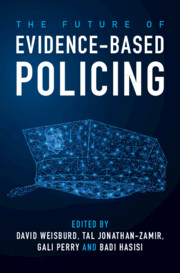Book contents
- The Future of Evidence-Based Policing
- The Future of Evidence-Based Policing
- Copyright page
- Contents
- Figures
- Tables
- Contributors
- Editors
- 1 The Future of Evidence-Based Policing
- Part I Taking Stock of Evidence-Based Policing
- 2 Three Tiers for Evidence-Based Policing
- 3 Re-inventing Policing
- 4 A Way Ahead
- Part II The Evidence for Evidence-Based Policing
- Part III Innovations in Tools of Evaluation and Assessment
- Part IV Challenges to the Implementation of Evidence-Based Policing
- Part V The Practitioner’s Perspective
- 17 Conclusions
- Index
- References
3 - Re-inventing Policing
Using Science to Transform Policing
from Part I - Taking Stock of Evidence-Based Policing
Published online by Cambridge University Press: 01 June 2023
- The Future of Evidence-Based Policing
- The Future of Evidence-Based Policing
- Copyright page
- Contents
- Figures
- Tables
- Contributors
- Editors
- 1 The Future of Evidence-Based Policing
- Part I Taking Stock of Evidence-Based Policing
- 2 Three Tiers for Evidence-Based Policing
- 3 Re-inventing Policing
- 4 A Way Ahead
- Part II The Evidence for Evidence-Based Policing
- Part III Innovations in Tools of Evaluation and Assessment
- Part IV Challenges to the Implementation of Evidence-Based Policing
- Part V The Practitioner’s Perspective
- 17 Conclusions
- Index
- References
Summary
In our 2011 paper on Police Science (Weisburd & Neyroud, 2011) we set our belief that a radical reformation of the role of science in policing will be necessary if policing is to become an arena of evidence-based policies. In this revised and updated version of our paper, we reinforce our argument that the advancement of science in policing is essential if police are to retain public support and legitimacy, cope with recessionary budget reductions, and deal with the myriad of problems that encompass modern police responsibilities. We outline a proposal for a new paradigm that changes the relationship between science and policing. This paradigm demands that the police adopt and advance evidence-based policy and that universities become active participants in the everyday world of police practice. But it also calls for a shift in ownership of police science from the universities to police agencies. Such ownership would facilitate the implementation of evidence-based practices and policies in policing and would change the fundamental relationship between research and practice. We add in this paper a new emphasis to our model that focuses attention to moral and ethical elements of research and practice that are an essential part of science in universities and must become a key element of EBP.
Keywords
- Type
- Chapter
- Information
- The Future of Evidence-Based Policing , pp. 44 - 63Publisher: Cambridge University PressPrint publication year: 2023
References
- 3
- Cited by

